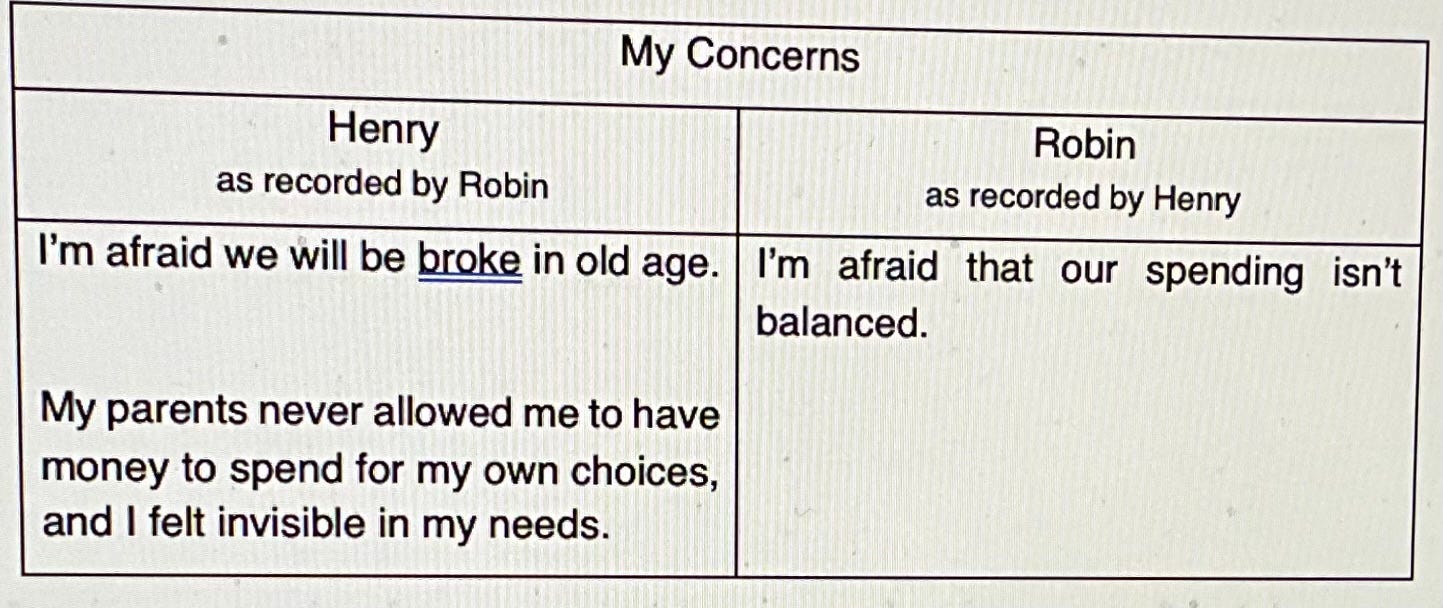“To be kind is more important than to be right.”
F. Scott Fitzgerald
So many couples have repeating tangled conversations over the same basic things. Money, bills, sex, or behaviors are a few of the most common. For some couples, their relationship has reached the point where most all disagreements lead back to these same old topics. The same repeating echoes of “you never..” or “you always..” raises the hackles of the “offending partner” to the degree that it seems impossible to be civil towards each other.
If you find yourself in a repeating tangled conversation you may have already tried applying the conversational techniques taught in Chapter Two of the Staying Together process, but to no avail. This happens when everyone’s patience is pushed to the limit, making it very difficult to get over the mountains of old disagreements.
Are there any options left to try? Yes, there are!
Let’s begin with each partner taking time on their own to answer a few questions. We will return to thoughts on how to share these responses with each other a bit later in the chapter.
Action Step
Begin by choosing one argument topic that you both agree to work on. Should we begin with the topic of Money? Please note that if this topic is too highly charged for either of you, it would be best to choose a different topic. The point of this exercise is to choose a topic that will serve as your guide in the future for how to dissect what is happening beneath the surface of a repeating tangled conversation.
Each of you should write the topic you have agreed upon on at the top of your own sheet of paper. Then, each should write their responses to the following questions, from their own viewpoint:
• How do arguments about [name of topic] usually begin?
• Is there a pattern that triggers these arguments such as:
o Is the Checkbook not balancing?
o Are there insufficient funds in one account?
o Does one of you spend money on items that the other does not agree with or thinks is unnecessary?
o Does discussing a future expense typically spark an argument?
• Have either of you tried to avoid having conversations about [this topic]? What do you do instead of talking about [this topic]?
• At what point during the conversation do things typically begin to unravel?
• At what point do either of you lose your temper? What happens when one or both of your temper’s flair?
The responses to the questions above are the first step to observing your old patterns, learning what doesn’t work, and identifying where you’ve gotten tripped up in the past.
Old patterns of arguing involve one or both people standing firm to their point of view, while the other person is firmly planted on the opposite side of the argument, or simply thinks differently
.
No disagreement will truly be solved when you stand on opposite sides of the “divide.”
Of course, one person can steam roll over top of the other, essentially forcing their partner to comply. Yet, compliance does not mean agreement. The partner who seemingly gives in will usually find a way around what has become a closed door. It forces them to become sneaky. Below are two examples of this behavioral pattern:
A wife has a history of impulse shopping and buys too many new shoes that she never wears. When her husband draws his absolute line in the sand demanding that no more shoes are purchased, the wife might nod in agreement and then go about hiding her new purchases in the car trunk until her husband is not at home giving her the opportunity to sneak the shoes into her closet and dispose of the new purchase evidence.
A wife has told her husband that he is spending too much money on golf games with his friends. He may nod in agreement to slow down his spending, but as a work-around he ensures that he pays cash when playing golf so his wife cannot track his spending.
Some partners have convinced themselves that this type of truth hiding is perfectly acceptable. In the examples provided above, each partner has silenced their knowing that a lie is a lie, even if it is not obviously “harmful” at first glance.
Being angry, laying down the law, forcing the other into agreement never works. At the bare minimum, your choice creates resentment and push back from your partner. At its worst, it creates the need to lie to each other. Resentment, push back, and lying to each other is not a winning solution for a strong partnership. It creates a power imbalance. “Power over” creates fear and resistance, where as “power with” creates unbreakable strength, respect, and trust.
I’m about to make a potentially controversial statement. It might not be something you agree with, and that is fine. It is OK to disagree with me. But I ask that you hang in there while we discuss this. I ask for you to temporarily set aside your disbelief and continue working through this chapter for insights into how to resolve repeating tangled disagreements.
Here’s the potentially controversial statement: The need to be right stems from insecurity.
A person has no trouble listening to another person’s point of view when they are comfortable and solid in what they are thinking, and decisions they have made. They can allow others to disagree with them without the discussion becoming an argument. The calm that this person feels within themselves is not shaken, and they do not become irritated. This is not simply a façade of calm rather it is an outcome of feeling secure in one’s thoughts and beliefs.
However, a head-to-head clash begins when one person in the discussion believes they must be right, or they must get their partner to agree with them. One strength of will colliding with the other is like two rams locking horns as they battle for dominance over the herd or for territory
.
What can you do instead of arguing?
What if you are certain that you are right?
What if your partner won’t budge from their position?
The Staying Together process offers a new path forward. There is zero to be gained from entering yet another tangled conversation. It is time to try out a new point of view.
The name of this chapter is “Not Me, But We”. Choosing this new viewpoint is a direct path to step outside the limitation of having to be right.
Are you willing to suspend your disbelief? Are you willing to try on a new point of view for the time you have devoted to the Staying Together process?
It will not necessarily be easy, but I can promise that changing your point of view will provide positive outcomes in the long run. When both partners feel heard and understood, it is possible to come to a mutual solution. The new solution which you arrive at is one that has not yet been considered. Taking the viewpoint of “Not Me, But We” requires courage, curiosity, and respect for each other. The intention to improve your relationship and the willingness to slow down and listen.
Let’s return to the example used earlier regarding money clashes. We know that hiding and lying do not work as solutions. Those choices only delay the disagreement and lead to a more intense reactions and feelings of being separate from the other.
Action Step – Set Up We Goals
Work together with your partner on the following Action Step.
At the top of a new piece of paper write the name of the discussion topic (without using any words of blame, shame, or guilt). In this example, write “Money Concerns: Not Me, But We.”
• On the next line on your sheet of paper write a statement that describes your We Goal. For example, your We Goal might be saving money to take a long vacation in Europe; saving for the down payment on your first home; or getting out of debt. Whatever the We Goals are, write them down. Note: this is not the place to write your personal financial goals.
• Listing your We Goals is something you and your partner need to come to a consensus. It is perfectly acceptable to have more than one We Goal. It is quite possible that this coming to consensus point is where your disagreements have historically begun.
• If you cannot agree on the We Goals, set this paper aside and move on to the Intermediate Action Step below.
• If you have successfully listed We Goals skip over the Intermediate Action Step and proceed to the Action Step: Coming Back Together.
Intermediate Action Step (if necessary)
To arrive at agreement about your goals, it is important to first understand what each of you is thinking, and what your needs are. In this intermediate step, focus on listening to understand, rather than only listening to create your next statement. It is important to move toward consensus when creating goals together. This process does not eliminate personal goals, instead the concept is to also work together toward creating We Goals.
• Lay a fresh sheet of paper sideways and divide it in two with a line down the middle.
• Title this page: My Concerns. One partner’s concerns will be listed on the left, and the other partner’s concerns will be listed on the right. The most important part of this step is for each of you to take turns writing down what your partner states as their concerns.
• No comments nor discussion happens during this process. Simply write down what the other says. Take your time, try very hard to not rush this step. It is possible that you will need to take a few breaks while working through this list. The goal during this step is to allow both of you to feel heard.
For example: imagine that Partner 1 (Henry) begins by speaking a concern “I’m afraid we will be broke in old age”. Partner 2 (Robin) writes down exactly what Henry just said under his name. After Robin writes down Henry’s concern, she then reads it out loud and checks with Henry that she wrote it correctly. (making any changes needed). Then Robin speaks “I’m afraid that our spending isn’t balanced”. Henry writes down exactly what Robin said under her name. Henry reads out loud what he wrote that Robin is concerned about and checks to be sure he got it correctly. (make any needed changes).
This back-and-forth process continues slowly, without discussion until both partners have their initial concerns written down.
It is normal and natural for each of you to become aware of yet unspoken concerns as this exercise is in process. Be kind to each other as the realizations come forward. A deeper concern might come forward from your memory such as: “I just remembered that my parents never allowed me to have money to spend for my own choices, and I felt invisible in my needs”. Write down these concerns also.
Continue this Action Step:
• Refer to the list made earlier about how arguments with your partner start, and what you typically do to avoid them (avoidance techniques are behaviors like loss of temper, the silent treatment, and/or throwing old arguments into the mix, refusing to discuss the topic further while insisting you are right etc.).
• Ask yourself if arguments with your partner feel familiar to your history as a child. What are you concerned will happen if the argument comes up? (e.g. You won’t care how I feel, you’ll stop loving me, you won’t listen to my needs).
• When both of you have spoken all your current concerns, take a moment to be sure you have each voiced and written out your major concerns. It is crucial to the process of returning to the state of “We” that you honor and understand your partner’s concerns, even if you do not agree with them.
Take a break at this point to give each of you time to fully consider what the other is saying.
Action Step: Coming Back Together
After you each have taken time to digest the concerns recorded in the Intermediate Action Step get back together and complete the following steps:
• Acknowledge to your partner that you have heard their concerns and that you now better understand their point of view. Ask for clarification if anything is confusing. Do not debate the validity of your partner’s statements, rather try only to understand them. Remember that your partner’s statements about their feelings and beliefs do not negate your feelings and beliefs. Acknowledging that you have heard your partner correctly is a sign of respect and love.
Communicate to your partner what your intentions have been for your partnership around money, and what you have observed needs to change for both of you to feel understood. This could be a variety of statements such as:
“My Mom kept track of the family spending, budgets, balancing check books etc. I thought that is what good women do for their partner, but I understand better now that if I try to do all of that by myself, you end up feeling controlled and left out. It isn’t my intention to make you feel that way, so we can totally change how we solve that aspect of money management. I don’t need to do the books alone. Either you can do them, or we can do them together if that would help.”
Or
“I never meant to make you feel like your needs weren’t important in our partnership, or to make you feel like you were invisible. I hate it when you feel that way. Let’s figure out how to change that because your needs matter as much as mine.”
• Continue respectfully discussing the concerns and fears of each partner until both of you feel understood.
• At this point in the Staying Together Process, it is vital you know and believe that your partner is sincere. If you have doubts, solve those first. The “Not Me, But We” technique is inviting new ways of communicating power with and for each other.
Action Step: Return to Setting Up “We Goals”
• The first question to ask each other is “how can we make this work for both of us?” and accept the truth that there is no need to be at odds with each other about money. You are both wise enough to create new solutions.
• Respectfully discuss what action steps are needed for each of your concerns to be resolved.
For the partner who is scared they won’t have money in the future, talk about how much money can be reasonably set aside each month to ease that person’s concerns. If the person’s request is way too high, gently talk about what is realistic and come to a number that is agreeable to both of you. Resolve where these savings will be kept and agree to discuss any withdrawals together.
For the partner who needs a sense of financial autonomy, even if it is a small amount, a separate account could be established for them to use without consulting the other partner. There are many options available for setting up your finances to allow for this need for autonomy.
You may need to speak with a financial consultant if your money issues are complex, but for the sake of an example here, the Staying Together process can offer a potential solution. One possibility for honoring autonomy is to set up three checking accounts: one for each partner, and one joint account for all shared expenses. When you create your monthly budget guidelines, establish a reasonable amount that will go into each person’s individual checking account that they may spend as they choose. Joint accounts could have an agreed upon limit of what can be spent on joint expenses without requiring a discussion.
With all the repeating disagreements within your relationship, begin with the thought of “How do we solve this together”. To solve things together, with your partner, you need to know how your partner feels. When you made the decision to become partners, you formed a bond. From now on, it is the two of you, standing side by side, addressing whatever problem there is. You never have to stand alone again. Your entire life up to this point has contributed to the way you feel about anything. If you observe that you have resistance to solving an issue using the “Not Me, But We” viewpoint, ask yourself what beliefs you are holding on to about this topic, and where did you learn to think that way
.
Fortunately, repeating disagreements rarely require an immediate answer. They typically are not an emergency. You can take your time as you move through this chapter. There is no need to bulldoze your way into a solution.
Spend time this week to carefully consider how you came to think the way you do, and if you are willing to look at a new solution which is best for both you and your partner. Consider what your words and actions convey to your partner and make the choice to be clearer in your communication.
Ask yourself “Who would I be, and how would I behave if I no longer believed…. [fill in the blank with the limiting belief you hold that causes discussions to hit a roadblock]?”
Practice observing yourself as you begin to feel strong emotions when presented with a repeating tangled conversation. Take the opportunity to courageously interrupt old patterns of behavior and ask yourself the question:
“How do We solve this dilemma together?”











I like the idea of setting “We Goals” for a commonly argued-about topic. My partner doesn’t like to do exercises like you’ve outlined here… but that doesn’t stop me from doing them, right? I can list the topics we typically argue about and how the arguments start, then think of some goals and share them the next time it happens. I have a long fuse and can typically stay calm for a while - enough to bring up the goals I think. Thanks for the advice ♥️.